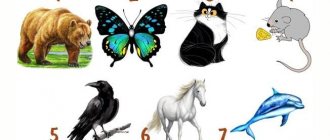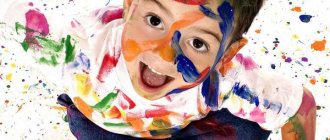When faced with a problem, do you strive to find as many solutions as possible? Do you use familiar things in everyday life for purposes other than their intended purpose? Do you have any artists, musicians or poets in your family? Do you often have crazy, unusual, and unlike anything thoughts come into your head? Can you act spontaneously, spontaneously, without much thought? Do you often imagine animals or objects instead of your friends?
Once you answer these questions, consider yourself to have passed a rapid test of creative thinking. If in most cases the answer is “yes”, then you have it; if “no”, it’s time to start developing it. What is it, why does modern man need it, and can it be somehow improved?
Creative thinking in psychology
In psychology, creativity is interpreted as a certain mental activity, practical or theoretical, as a result of which new hypotheses, proposals, and methods for solving them arise. It plays a large role in science, where creative people provide serious assistance in discoveries due to the fact that they think more broadly and act more boldly.
Note! Creative thinking is constructive, the task of which is to discover everything new and unique.
Psychology emphasizes the main non-standard characteristic of this thought process, which is its creativity. Broadness of thinking can be achieved through the development of imagination, starting from a young age in preschoolers. Training can be done with adults, but the process will take longer.
E. Torrance tests
Another popular method for diagnosing abilities is tests by psychologist Alice Paul Torrance. The study of creativity by E. Thorens represents parts that characterize creativity at the verbal, visual and sound levels.
Torrance tests are performed at a specified time interval. The result obtained is assessed according to certain principles:
- Execution speed, the number of solutions completed within a certain period of time.
- Variety of answers.
- Uniqueness of the proposed solutions.
- Concretization of ideas and solutions.
E. Torrance's tests were developed in the 60s and are suitable for people of all ages and young children. Torrance tests have been constantly modified and improved, and have many similar variants.
Definition
Creative thinking - what is it in psychology
Human creative thinking is the process of getting acquainted with information, processing it and creating new ideas. In pedagogy, the importance of this type of thinking is noted due to the fact that the individual independently strives to obtain new knowledge and quickly apply it in practice. This applies not only to music and drawing lessons, but also to history, social studies, etc. In addition, speaking about children with a predisposition to this type of thinking, the importance of having this criterion for learning, as well as socialization, is noted.
Part 2. How to increase your creative potential
Each of us has a different ability to come up with creative solutions. Fortunately, this ability can be improved. There are two main ways:
- environmental change
- use of special techniques
I will share several principles for working with the environment that I use myself and have scientific confirmation. Several good books have been written on the topic of special techniques. I will share the list at the end of the article.
What can increase creative potential:
1. Switching between tasks You've probably heard the story about Archimedes, who came up with a solution to a problem while sitting in the bathroom. About Newton, who made his discovery while sitting in the garden under an apple tree. About Einstein, who loved to play the violin in between thoughts. All these individuals were engaged in a process that in science is usually called mind wandering.
Mind wandering is considered an important process in creative thinking. This process allows you to find non-trivial connections between ideas. The opposite of it is considered cognitive fixation - a process when you are literally fixated on the chosen solution to a problem and do not see alternative approaches.
Creative thinking itself is usually divided into two types: divergent and convergent. Divergent thinking is the ability to find multiple solutions to the same problem. Convergent thinking is to choose the most effective of these solutions.
A 2022 study found that task switching can reduce cognitive fixations and increase the effectiveness of both types of creative thinking. Moreover, for convergent thinking the effect was stronger.
The subjects were divided into three groups. Each group had 12 minutes to complete the task. The first group had to switch between tasks every 30 seconds. The second one worked in a mode that was comfortable for her. The third had to work for 6 minutes without switching on the first task, then 6 minutes on the second task.
The first group coped with the task significantly better than the other two. Interestingly, the second group showed the same result as the third. That is, we instinctively choose an ineffective strategy for working on creative tasks.
2. Come up with ideas alone, discuss collectively When working on a new product, you have to organize collective brainstorming sessions. Alas, these meetings do not always end productively.
I immediately remember the cartoon about Winnie the Pooh, where Winnie says: “These are some wrong bees, and they make the wrong honey.” It’s the same with brainstorming: it’s somehow wrong. There is a residue after the meeting that you didn’t learn anything new and wasted your time.
Science has suggested a way to solve the problem here too. The effectiveness of brainstorming can be increased by asking each participant to come up with several solutions to the problem alone. And use a joint meeting not to generate options, but to select the best from the general list. Such a simple solution increased the “novelty” of the proposed solutions.
Why it worked: group work inclines a person to make conforming decisions and the emergence of cognitive fixation. This is the tendency to become overly focused on one single solution. During group work, participants began to spin existing ideas, instead of searching for fundamentally new solutions.
3. Music The researchers decided to look at how different types of music would influence creative thinking. They selected four modes of music: calm, happy, sad and anxious. The control group worked in silence.
The functioning of divergent thinking was tested using the task “think of as many ways as possible to use a brick.” And the work of convergent thinking is done through a test of verbal creativity to find a connecting word for the other three.
It turned out that happy music increased the efficiency of divergent thinking and had almost no effect on convergent thinking. Unfortunately, for other types of music I did not find any results of influence on creativity. If you find it, I will be very happy and will add it to the article.
Here you can find original compositions from the study.
4. Humor Divergent thinking directly depends on the current emotional state. The first way to lift your mood is to listen to happy music. The second way is humor.
Spontaneous jokes relax a person and involve distracted attention instead of focused attention. This promotes the emergence of non-obvious connections between different ideas. The resulting solutions are novel and original.
Humor has a positive effect not only on the quality of the decisions themselves, but also on their quantity. In an MIT study, improv comedians came up with 20% more ideas and 25% more creative solutions than professional product designers.
You can learn a lot from professional improvisers. This is what happened with the participants in the experiment at MIT. The subjects who completed the special workshop completed the task 37% better than before the training.
One of the most effective techniques in improvisational comedy is “Yes, and.” The task: to continue the story behind the partner so that she does not lose interest. You must simultaneously agree with the previous partner and provide a clue for the next one, so that he can also continue the story in an interesting way.
5. Reproduction of ideas (recall)
The same area of the brain is responsible for reproducing information and creating new ideas. One of the benefits of replication: creating associations with other ideas. Reproduction of information creates greater potential for the generation of new ideas.
At its core, creative thinking is connecting two ordinary objects in an unusual way. Reproduction moves information from long-term to working and allows for active mental operations. This way you can combine old information with what you just learned and get a new solution.
I actively use this technique using a personal diary. I write down on paper any thought that comes to mind. In a month and a half of actively using technology, I came up with ideas for 15 projects that I want to implement in the future. I appreciate the usefulness of these ideas.
Features of creative thinking
Divergent thinking - what is it?
Creative thinking has little to do with actors, artists and musicians; not all people of this mindset are artists. An individual may have several thinking traits that determine his creative direction.
Among the features of creative thinking are:
- Uniqueness. The desire to create something new, be it an idea or an object. A creative person does not base himself on other people’s examples, he develops something of his own;
- Conceptual flexibility. The ability to apply a different point of view to a certain phenomenon in an attempt to consider it more broadly, in unusual variations in order to make it unique;
- Spontaneity. Free switching from one thought to another. Perception of information from different sources. The spontaneity of an idea arising in a situation that was not conducive to it;
- Heuristic. Transforming the familiar, going beyond the boundaries are essential skills in creative thinking.
An important property of creativity is going beyond the usual
Is it possible to control creative thinking?
Logical thinking - what is it and how to develop it in an adult and a child
We can say unequivocally about the possibility of controlling thinking - it exists. However, much depends on the individual who wants to start training it or already has it, but has control problems.
First of all, you need to decide whether you want to control your thought processes. Willpower works like a global purchase of motivation - you can’t do without it. Then it is worth following some kind of plan, methods of controlling creative thinking, be it its development or limitation.
What promotes the development of creative thinking
The trait of creativity may appear in a child, or it may be “late,” and the creative mind will mature later. It is important to pay attention to this issue in the process of education, then creative activity will bear fruit very soon.
Note! Everything that differs from the usual perception of an individual, that can provoke an independent exit from the comfort zone, contributes to the formation of a creative direction of thinking. For example, meeting new people from a different social circle, as well as visiting unfamiliar places. It is important to awaken research interest so that the individual has thoughts about a particular phenomenon.
Test E. Tunik
E. Tunik’s test is aimed at determining creativity in adolescents and adults. The test helps to identify a person’s predisposition to the following criteria:
- Curiosity. An inquisitive person with an interesting character. He is interested in the world around him, is engaged in self-knowledge, loves to think and learn the structure of new things, the mechanisms of work, does interesting work, reads books, learns as much new information as possible.
- Riskiness. Risk-taking is manifested in defending one’s ideas and thoughts in front of others, is not afraid of the possible negative reaction of people to creativity, and has a strong character. A risk-taker has a goal and goes towards it, despite possible obstacles, is ready for the consequences of mistakes, and is ready to take risks to achieve the final result. Considers the opinions of other people, but does not give in to provocations.
- Imagination helps a person to come up with new events and things that never existed in reality, to see objects that have no analogues and what is hidden from the eyes of the common man. Imagination contributes to the creation of works of art and literature.
- Preparedness for difficulties. A person with a complex character studies complex phenomena and objects. He does not look for easy ways to solve assigned problems; he does everything independently, at his own peril and risk. Studying complex things is an integral part of the life of such a person.
Methods for developing creative thinking
Experts offer different ways to help develop creativity.
Lateral thinking
It is important to develop literal thinking, i.e. “redirected”. There are three stages of this method: focus-break-connection, where:
- It is necessary to select a “reference point” - an object on which the individual will focus;
- Having chosen an object to focus on, you need to “break the logic” of this object. Starting from the usual pattern, it is violated and changed;
- It is possible that you will get an absurd idea about a subject, then you need to find something logical in the resulting result.
Six Hats Method
The role-playing game “six hats” will contribute to developed thinking. Hats are usually fictitious, the point being to give a particular hat color and give it a role. By “putting on” one hat or another, an individual switches on the corresponding mode of thinking. In other words, the method not only develops imagination, but also helps to solve a possible problem by looking at it from different angles and applying different points of view.
Trying on different roles not only develops creativity, but also solves problems
Reverse brainstorming
This technique is quite contradictory, since you need to look not for a solution to a certain problem, but for its worsening. Instead of talking about “how to fix it,” the wording is changed to “how to make it worse.” You need to draw up all possible options that could lead to complete failure and consider them. The root of the problem may lie in the proposed options. Therefore, an adequate solution that can help can be found faster than with a regular brainstorming.
Reading inscriptions backwards
It is better to do reverse reading at least in pairs. When a person reads words from the end, the brain literally activates creativity to understand what is being said. So, one person reads it backwards, the other person guesses the original phrase.
Pun
The play on words has many variations, for example:
- The most common one is to name two slightly similar words and look for their similarities in properties, colors, etc.
- A children's game that requires you to find a rhyme for a word, often a name, is also suitable for training an adult.
- There is also an option in which a person is offered a certain number of words, for example, 15. Using each of them, changing their places, adding new ones, you need to come up with a story.
- At first glance, it’s a simple game, but in reality it’s a complex game where you’re given one letter of the alphabet, and within 15 minutes you need to write as many words as possible on it.
Creative thinking is valued for its ability to create something unique. Despite the association of creativity with musicians and artists, representatives of this type of thinking are far from limited to these professions. It is of great importance in science, pedagogy, economics, almost everywhere. The important thing is that this mental orientation can be trained.
Stereotypes
A talented person is talented in everything. What talent do you have? It cannot be that there is no talent: even a song performed at a corporate party may well turn out to be a sign of real talent. It's all about the stereotypes that are imposed on us by life itself or by the people who surround us since childhood. They are the ones who tell us what is “good” and what is “bad”. As a result, we, like staunch tin soldiers, carry out tasks strictly according to instructions.
Now remember how in childhood you easily got out of any situation. If you can't remember yourself, take a close look at how your own child does it.
The first thing that distinguishes a child from an adult is the ability to think freely figuratively. For a child, every word is a whole picture, every event is a fairy tale. The kid himself can easily transform into any fairy-tale hero and for this he does not have to wait for a costume party. External resemblance to a famous character doesn’t bother him much; he has a creative (different from the generally accepted) approach to everything.
Over the years we are losing this road. We learn rules that we rarely want to break. All because it’s easier, more familiar. Such actions do not cause indignation (envy) of colleagues, do not infuriate (misunderstanding) parents/husband/wife/ and so on.
Most people agree to play according to standard rules. And then the person becomes bored with himself, with his family, with his friends. Meanwhile, her “crazy” classmate Yulka has already headed a department in a large state corporation, her husband is a famous and fashionable photographer (he, by the way, is also “out of this world”). They are happy, and soon they will have their first and, of course, talented child.
So you have something to strive for.
Creativity is just the ability, under normal conditions with all the known components, to put together something that will make, if not turn the world upside down, then at least look at things differently.
Therefore, creative people are especially valued in advertising agencies. They are the ones who force us to buy something that just five minutes ago we didn’t want at all. They are the ones who make us swallow saliva at the mere appearance of “low-calorie” yogurt on the screen. They are the ones who know how to direct our standard thoughts along any path they need.










